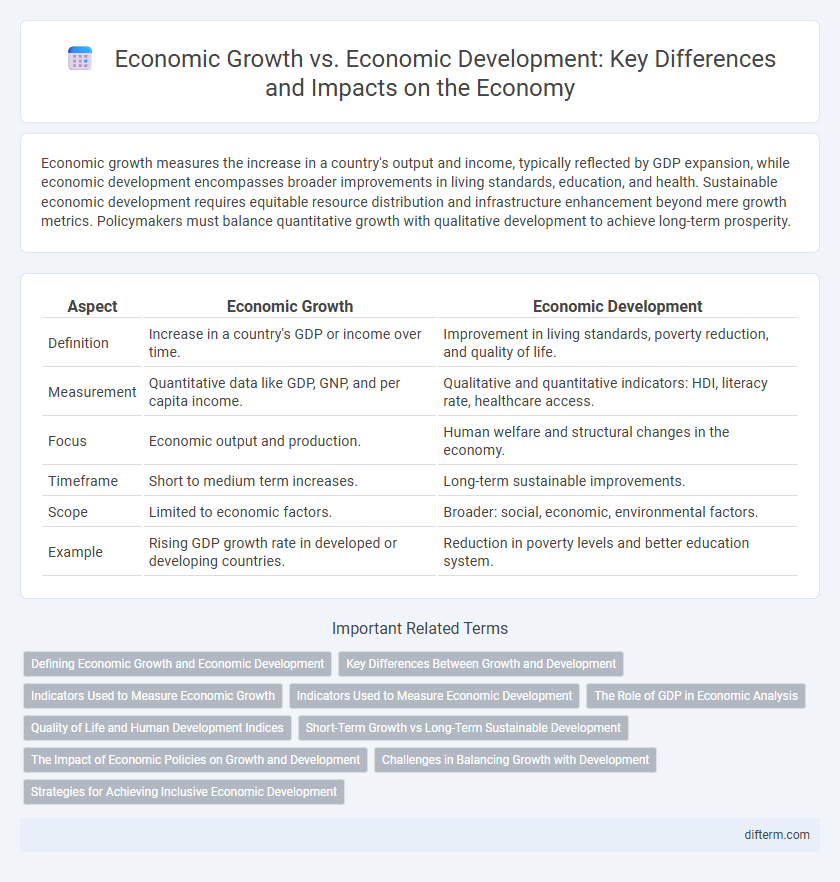Economic growth measures the increase in a country's output and income, typically reflected by GDP expansion, while economic development encompasses broader improvements in living standards, education, and health. Sustainable economic development requires equitable resource distribution and infrastructure enhancement beyond mere growth metrics. Policymakers must balance quantitative growth with qualitative development to achieve long-term prosperity.
Table of Comparison
| Aspect | Economic Growth | Economic Development |
|---|---|---|
| Definition | Increase in a country's GDP or income over time. | Improvement in living standards, poverty reduction, and quality of life. |
| Measurement | Quantitative data like GDP, GNP, and per capita income. | Qualitative and quantitative indicators: HDI, literacy rate, healthcare access. |
| Focus | Economic output and production. | Human welfare and structural changes in the economy. |
| Timeframe | Short to medium term increases. | Long-term sustainable improvements. |
| Scope | Limited to economic factors. | Broader: social, economic, environmental factors. |
| Example | Rising GDP growth rate in developed or developing countries. | Reduction in poverty levels and better education system. |
Defining Economic Growth and Economic Development
Economic growth measures the increase in a country's output of goods and services, typically quantified by the rise in Gross Domestic Product (GDP) over time. Economic development encompasses broader progress, including improvements in living standards, education, health, and income distribution alongside economic growth. While economic growth reflects quantitative expansion, economic development emphasizes qualitative changes that enhance overall well-being and socio-economic conditions.
Key Differences Between Growth and Development
Economic growth refers to the increase in a country's output of goods and services, typically measured by GDP, indicating quantitative expansion. Economic development encompasses broader improvements including income distribution, quality of life, education, and health standards, reflecting qualitative progress. Key differences lie in growth's focus on output metrics while development addresses structural changes and social well-being.
Indicators Used to Measure Economic Growth
Economic growth is primarily measured through indicators such as Gross Domestic Product (GDP), GDP per capita, and industrial output, reflecting the increase in a country's production and income over time. Other quantitative metrics include employment rates, productivity levels, and investment rates, which provide insights into the economy's capacity expansion and efficiency. These indicators focus on short-term economic performance rather than broader social progress or quality of life improvements associated with economic development.
Indicators Used to Measure Economic Development
Economic development is measured using a variety of indicators that capture social and structural progress beyond GDP growth, including literacy rates, life expectancy, and access to healthcare. Human Development Index (HDI) combines income, education, and health metrics to provide a composite measure of economic development. Other key indicators include poverty rates, employment quality, and income distribution, reflecting the broader well-being and sustainability of growth within an economy.
The Role of GDP in Economic Analysis
Gross Domestic Product (GDP) serves as a key indicator in economic growth analysis, quantifying the total value of goods and services produced within a country. While GDP highlights economic expansion, it does not capture qualitative aspects of economic development such as income distribution, health, and education. Analysts use GDP alongside social and environmental metrics to obtain a comprehensive understanding of a nation's true economic progression.
Quality of Life and Human Development Indices
Economic growth refers to the increase in a country's output of goods and services, typically measured by GDP, while economic development encompasses improvements in quality of life, including health, education, and income distribution. Human Development Indices (HDI) evaluate progress by assessing life expectancy, educational attainment, and per capita income, providing a broader measure than mere economic growth. Emphasizing human development alongside economic growth ensures policies enhance overall well-being and sustainable societal advancement.
Short-Term Growth vs Long-Term Sustainable Development
Economic growth measures the increase in a country's GDP over a short period, reflecting immediate economic output and productivity gains, while economic development encompasses long-term improvements in living standards, education, and infrastructure. Short-term growth boosts income and employment but may lead to resource depletion and environmental degradation if not managed sustainably. Sustainable development integrates economic, social, and environmental goals to ensure lasting prosperity and equitable wealth distribution across generations.
The Impact of Economic Policies on Growth and Development
Economic policies significantly influence economic growth by shaping factors such as investment rates, inflation control, and employment levels, directly impacting GDP expansion. Development policies, however, extend beyond growth metrics to include improvements in healthcare, education, and income distribution, fostering sustainable human capital advancement. Effective economic strategies integrate both growth stimulation and developmental goals to promote long-term prosperity and social well-being.
Challenges in Balancing Growth with Development
Balancing economic growth with economic development presents significant challenges, as rapid GDP increases often lead to unequal wealth distribution and environmental degradation. Policymakers must address social issues such as poverty reduction, education, and healthcare to ensure inclusive progress beyond mere output expansion. Sustainable strategies require integrating long-term human capital investments with environmentally responsible growth models to achieve balanced and equitable economic advancement.
Strategies for Achieving Inclusive Economic Development
Inclusive economic development requires strategies that promote equitable resource distribution, enhance access to quality education and healthcare, and support small and medium enterprises through targeted financial incentives. Governments can implement social protection programs and invest in infrastructure to reduce regional disparities and create job opportunities for marginalized communities. Empowering women and fostering innovation through technology adoption also play crucial roles in driving sustainable and inclusive economic progress.
Economic Growth vs Economic Development Infographic

 difterm.com
difterm.com